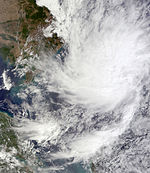2010 Pacific typhoon season
| 2010 Pacific typhoon season |

Season summary map
|
| Seasonal boundaries |
| First system formed |
January 18, 2010 |
| Last system dissipated |
December 20, 2010 |
| Strongest storm |
|
| Name |
Megi |
| • Maximum winds |
230 km/h (145 mph)
(10-minute sustained) |
| • Lowest pressure |
885 hPa (mbar) |
| Seasonal statistics |
| Total depressions |
29 |
| Total storms |
14 official, 1 unofficial (record low)
|
| Typhoons |
7 |
| Super typhoons |
1 (unofficial)
|
| Total fatalities |
353 |
| Total damage |
$1.29 billion (2010 USD) |
| Related articles |
|
|
Pacific typhoon seasons
2008, 2009, 2010, 2011, 2012
|
| Tropical depression (JMA) |
| Tropical depression (SSHWS) |
|
|
| Duration |
January 18 – January 20 |
| Peak intensity |
55 km/h (35 mph) (10-min) 1006 hPa (mbar) |
| Tropical storm (JMA) |
| Tropical storm (SSHWS) |
|
|
| Duration |
March 20 – March 26 |
| Peak intensity |
65 km/h (40 mph) (10-min) 998 hPa (mbar) |
| Tropical depression (JMA) |
|
|
| Duration |
April 26 – April 26 |
| Peak intensity |
<55 km/h (35 mph) (10-min) 1008 hPa (mbar) |
| Tropical depression (JMA) |
|
|
| Duration |
June 3 – June 5 |
| Peak intensity |
<55 km/h (35 mph) (10-min) 1002 hPa (mbar) |
| Typhoon (JMA) |
| Category 1 typhoon (SSHWS) |
|
|
| Duration |
July 11 – July 18 |
| Peak intensity |
130 km/h (80 mph) (10-min) 970 hPa (mbar) |
| Typhoon (JMA) |
| Category 1 typhoon (SSHWS) |
|
|
| Duration |
July 17 – July 23 |
| Peak intensity |
130 km/h (80 mph) (10-min) 970 hPa (mbar) |
| Tropical depression (JMA) |
|
|
| Duration |
July 18 – July 20 |
| Peak intensity |
55 km/h (35 mph) (10-min) 1004 hPa (mbar) |
| Tropical depression (JMA) |
|
|
| Duration |
July 23 – July 24 |
| Peak intensity |
<55 km/h (35 mph) (10-min) 1008 hPa (mbar) |
| Tropical depression (JMA) |
|
|
| Duration |
July 26 – July 28 |
| Peak intensity |
55 km/h (35 mph) (10-min) 1002 hPa (mbar) |
The 2010 Pacific typhoon season was the least active Pacific typhoon season on record, featuring only 14 named storms; seven of them strengthened into typhoons while one reached super typhoon intensity. Very unusual, with an exceptionally low activity within the basin, the Pacific typhoon season during 2010 was much weaker compared to the Atlantic hurricane season. The last and only time that such a record like this occurred was during 2005. During the season no storms have made landfall in mainland Japan, the only second such occurrence since 1988. Also, all of the 14 named storms developed west of 150°E. Moreover, the season had an index total Accumulated Cyclone Energy (ACE) of 115, which is the second lowest in the basin after 1999. It was also the fourth consecutive year with a below average ACE index.
The season ran throughout 2010, though most tropical cyclone tend to develop between May and October. The season’s first named storm, Omais, developed on March 24 while the season’s last named storm, Chaba dissipated or became extratropical on October 30. During the season only two storms were notable. Typhoon Kompasu was the strongest storm to make landfall over in South Korea in 15 years. During October, Typhoon Megi reached its peak intensity with a minimum barometric pressure of 885 hPa, making it one of the most intense typhoons ever recorded. In addition, a rare subtropical storm have developed during December and intensified into Tropical Storm Omeka where it crossed the basin.
The scope of this article is limited to the Pacific Ocean to the north of the equator between 100°E and 180th meridian. Within the northwestern Pacific Ocean, there are two separate agencies that assign names to tropical cyclones which can often result in a cyclone having two names. The Japan Meteorological Agency (JMA) will name a tropical cyclone should it be judged to have 10-minute sustained wind speeds of at least 65 km/h (40 mph) anywhere in the basin, whilst the Philippine Atmospheric, Geophysical and Astronomical Services Administration (PAGASA) assigns names to tropical cyclones which move into or form as a tropical depression in their area of responsibility located between 135°E and 115°E and between 5°N–25°N regardless of whether or not a tropical cyclone has already been given a name by the JMA. Tropical depressions that are monitored by the United States' Joint Typhoon Warning Center (JTWC) are given a number with a "W" suffix.
...
Wikipedia



















